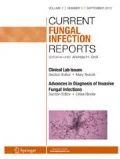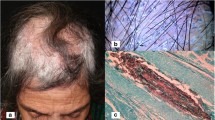Abstract
Purpose of Review
This review summarizes the fungal literature currently available for tinea capitis (TC), as well as providing data for clinical utility.
Recent Findings
Available studies in TC are scarce; however, they provide important information about efficacy and outcome in clinical practice.
Summary
Treatment of TC is effective; however, it requires a minimum of 1 month. Systemic treatment is often required to favor enhance drug penetration into the deep part of the hair follicle. The newest oral antifungal has higher efficacy rates than conventional therapy, as well as much shorter duration of treatment but at higher costs. We perform a review of the literature including treatment schemes.

Similar content being viewed by others
References
Papers of particular interest, published recently, have been highlighted as: • Of importance •• Of major Importance
Bennassar A, Grimalt R. Management of tinea capitis in childhood. Clin Cosmet Investig Dermatol. 2010;3:89–98.
• Rebollo N, López-Barcenas AP, Arenas R. Tinea capitis. Actas Dermosifiliogr. 2008;99(2):91–100. This paper is an overview of the disease.
Hay RJ, Robles W, Midgley G, Moore MK. European Confederation of Medical Mycology Working Party on Tinea Capitis. Tinea capitis in Europe: new perspective on an old problem. J Eur Acad Dermatol Venereol. 2001;15(3):229–33.
• Kallel A, Hdider A, Fakhfakh N, Belhadj S, Belhadj-Salah N, Bada N, et al. Tinea capitis: main mycosis child. Epidemiological study on 10 years. J Mycol Med. 2017;27(3):345–50. This paper showed the most common clinical manifestations of tinea capitis in children.
Ziegler W, Lempert S, Goebeler M, Kolb-Mäurer A. Tinea capitis: temporal shift in pathogens and epidemiology. J Dtsch Dermatol Ges. 2016;14(8):818–25. (Abstract)
Kieliger S, Glatz M, Cozzio A, Bosshard PP. Tinea capitis and tinea faciei in the Zurich area - an 8-year survey of trends in the epidemiology and treatment patterns. J Eur Acad Dermatol Venereol. 2015;29(8):1524–9.
Sei Y. 2011 epidemiological survey of dermatomycoses in Japan. Med Mycol J. 2015;56(4):J129–35.
• Brito-Santos F, Figueiredo-Carvalho MHG, Coelho RA, Sales A, Almeida-Paes R. Tinea capitis by Microsporum audouinii: case reports and review of published global literature 2000‑2016. Mycopathologia. 2017;182(11–12):1053–60. An important review of the disease mainly on therapeutic options
Niczyporuk W, Krajewska-Kułak E, Łukaszuk C. Tinea capitis favosa in Poland. Mycoses. 2004;47(5–6):257–60.
Khosravi AR, Shokri H, Vahedi G. Factors in etiology and predisposition of adult tinea capitis and review of published literature. Mycopathologia. 2016;181(5–6):371–8.
•• Hay RJ. Tinea capitis: current status. Mycopathologia. 2017;182(1–2):87–93. This paper gives important strategies for treating tinea capitis.
Martínez-Suárez H, Guevara-Cabrera N, Mena C, Valencia A, Araiza J, Bonifaz A. Tiña de la cabeza. Reporte de 122 casos. Derma CMQ. 2007;5(1):9–14.
Bonifaz A, Carrasco-Gerard E, Palacios-López C, Araiza J. Tratamiento de la cabeza con dosis intermitentes (semanales) de fluconazol. Derma Cosmet Med Quir. 2003;1:11–9.
Gupta AK, Summerbell RC. Tinea capitis. Med Mycol. 2000;38(4):255–87.
Ilkit M, Demirhindi H. Asymptomatic dermatophyte scalp carriage: laboratory diagnosis, epidemiology and management. Mycopathologia. 2008;165(2):61–71.
Zurita J, Hay RJ. Adherence of dermatophyte microconidia and arthroconidia to human keratinocytes in vitro. J Investig Dermatol. 1987;89(5):529–34.
Sriranganadane D, Waridel P, Salamin K, Feuermann M, Mignon B, Staib P, et al. Identification of novel secreted proteases during extracellular proteolysis by dermatophytes at acidic pH. Proteomics. 2011;11(22):4422–33.
Staib P, Zaugg C, Mignon B, Weber J, Grumbt M, Pradervand S, et al. Differential gene expression in the pathogenic dermatophyte Arthroderma benhamiae in vitro versus during infection. Microbiology. 2010;156(Pt3):884–95.
Niyonsaba F, Ogawa H. Protective roles of the skin against infection: implication of naturally occurring human antimicrobial agents beta-defensins, cathelicidin LL-37 and lysozyme. J Dermatol Sci. 2005;40(3):157–68.
Abdelaal NH, Rashed LA, Ibrahim SY, Abd El Halim MH, Ghoneim N, Saleh NA, et al. Cathelicidin (LL-37) level in the scalp hair of patients with tinea capitis. Med Mycol. 2017;55(7):733–6.
Mao L, Zhang L, Li H, Chen W, Wang H, Wu S, et al. Pathogenic fungus Microsporum canis activates the NLRP3 inflammasome. Infect Immun. 2014;82(2):882–92.
Wagner DK, Sohnle PG. Cutaneous defenses against dermatophytes and yeasts. Clin Microbiol Rev. 1995;8(3):317–35.
Calderon RA, Hay RJ. Fungicidal activity of human neutrophils and monocytes on dermatophyte fungi, Trichophyton quinckeanum and Trichophyton rubrum. Immunology. 1987;61(3):289–95.
Sakuragi Y, Sawada Y, Hara Y, Ohmori S, Omoto D, Haruyama S, et al. Increased circulating Th17 cell in a patient with tinea capitis caused by Microsporum canis. Allergol Int. 2016;65(2):215–6.
Gorgievska-Sukarovska B, Skerlev M, Žele-Starčević L, Husar K, Halasz M. Kerion celsi due to Microsporum canis with a dermatophytid reaction. Acta Dermatovenerol Croat. 2017;25(2):151–4.
Brissos J, Gouveia C, Neves C, Varandas L. Remember kerion celsi. BMJ Case Rep. 2013;2013
de Hoog GS, Dukik K, Monod M, Packeu A, Stubbe D, Hendrickx M, et al. Toward a novel multilocus phylogenetic taxonomy for the dermatophytes. Mycopathologia. 2017;182(1–2):5–31.
Farooqi M, Tabassum S, Rizvi DA, Rahman A, Rehanuddin, Awan S, et al. Clinical types of tinea capitis and species identification in children: an experience from tertiary care centres of Karachi, Pakistan. J Pak Med Assoc. 2014;64(3):304–8.
Kefalidou S, Odia S, Gruseck E, Schmidt T, Ring J, Abeck D. Wood’s light in Microsporum canis positive patients. Mycoses. 1997;40(11–12):461–3.
Robert R, Pihet M. Conventional methods for the diagnosis of dermatophytosis. Mycopathologia. 2008;166(5–6):295–306.
Symoens F, Jousson O, Planard C, Fratti M, Staib P, Mignon B, et al. Molecular analysis and mating behaviour of the Trichophyton mentagrophytes species complex. Int J Med Microbiol. 2011;301(3):260–6.
Kanbe T, Suzuki Y, Kamiya A, Mochizuki T, Kawasaki M, Fujihiro M, et al. Species-identification of dermatophytes Trichophyton, Microsporum and Epidermophyton by PCR and PCR-RFLP targeting of the DNA topoisomerase II genes. J Dermatol Sci. 2003;33(1):41–54.
Brillowska-Dabrowska A, Michałek E, Saunte DM, Nielsen SS, Arendrup MC. PCR test for Microsporum canis identification. Med Mycol. 2013;51(6):576–9.
Verrier J, Krähenbühl L, Bontems O, Fratti M, Salamin K, Monod M. Dermatophyte identification in skin and hair samples using a simple and reliable nested polymerase chain reaction assay. Br J Dermatol. 2013;168(2):295–301.
Deng S, Zhou Z, de Hoog GS, Wang X, Abliz P, Sun J, et al. Evaluation of two molecular techniques for rapid detection of the main dermatophytic agents of tinea capitis. Br J Dermatol. 2015;173(6):1494–500.
Deng S, de Hoog GS, Verweij PE, Zoll J, Ilkit M, Morsali F, et al. In vitro antifungal susceptibility of Trichophyton violaceum isolated from tinea capitis patients. J Antimicrob Chemother. 2015;70(4):1072–5.
Brasileiro A, Campos S, Cabete J, Galhardas C, Lencastre A, Serrão V. Trichoscopy as an additional tool for the differential diagnosis of tinea capitis: a prospective clinical study. Br J Dermatol. 2016;175(1):208–9.
Elghblawi E. Tinea capitis in children and trichoscopic criteria. Int J Trichology. 2017;9(2):47–9.
Lu M, Ran Y, Dai Y, Lei S, Zhang C, Zhuang K, et al. An ultrastructural study on corkscrew hairs and cigarette-ash-shaped hairs observed by dermoscopy of tinea capitis. Scanning. 2016;38(2):128–32.
Schechtman RC, Silva ND, Quaresma MV, Bernardes Filho F, Buçard AM, Sodré CT. Dermatoscopic findings as a complementary tool in the differential diagnosis of the etiological agent of tinea capitis. An Bras Dermatol. 2015;90(3 Suppl 1):13–5.
Campos S, Brasileiro A, Galhardas C, Apetato M, Cabete J, Serrão V, et al. Follow-up of tinea capitis with trichoscopy: a prospective clinical study. J Eur Acad Dermatol Venereol. 2017;31(11):e478–80.
Arrazola-Guerrero J, Isa-Isa R, Torres-Guerrero E, Arenas R. Tinea capitis. Dermoscopic findings in 37 patients. Rev Iberoam Micol. 2015;32(4):242–6.
Velho GD, Selores M, Amorim I, Lopes V. Guess what! Tinea capitis by Trichophyton schöenleinii. Eur J Dermatol. 2001;11(5):481–2.
Fuller LC, Barton RC, Mohd Mustapa MF, Proudfoot LE, Punjabi SP, Higgins EM. British Association of Dermatologists’ guidelines for the management of tinea capitis 2014. Br J Dermatol. 2014;171(3):454–63.
Chen X, Jiang X, Yang M, González U, Lin X, Hua X, et al. Systemic antifungal therapy for tinea capitis in children. Cochrane Database Syst Rev. 2016;5:CD004685.
•• Chen X, Jiang X, Yang M, Bennett C, González U, Lin X, et al. Systemic antifungal therapy for tinea capitis in children: an abridged Cochrane review. J Am Acad Dermatol. 2017;76(2):368–74. An important paper that summarizes the clinical trials available for tinea capitis
Tey HL, Tan AS, Chan YC. Meta-analysis of randomized, controlled trials comparing griseofulvin and terbinafine in the treatment of tinea capitis. J Am Acad Dermatol. 2011;64(4):663–70.
Shemer A, Grunwald MH, Gupta AK, Lyakhovitsky A, Daniel CR 3rd, Amichai B. Griseofulvin and fluconazole reduce transmission of tinea capitis in schoolchildren. Pediatr Dermatol. 2015;32(5):696–700.
Danielli LJ, Lopes W, Vainstein MH, Fuentefria AM, Apel MA. Biofilm formation by Microsporum canis. Clin Microbiol Infect. 2017;23(12):941–2.
Shemer A, Plotnik IB, Davidovici B, Grunwald MH, Magun R, Amichai B. Treatment of tinea capitis - griseofulvin versus fluconazole - a comparative study. J Dtsch Dermatol Ges. 2013;11(8):737–41–2. (Abstract)
Kakourou T, Uksal U, European Society for Pediatric Dermatology. Guidelines for the management of tinea capitis in children. Pediatr Dermatol. 2010;27(3):226–8.
Papaiordanou F, da Silveira BR, Abulafia LA. Hypersensitivity reaction to Sporothrix schenckii: erythema nodosum associated with sporotrichosis. Rev Soc Bras Med Trop. 2015;48(4):504.
Author information
Authors and Affiliations
Corresponding author
Ethics declarations
Conflict of Interest
The authors declare that they have no competing interests.
Human and Animal Rights and Informed Consent
This article does not contain any studies with human or animal subjects performed by any of the authors.
Additional information
This article is part of the Topical Collection on Fungal Infections of Skin and Subcutaneous Tissue
Rights and permissions
About this article
Cite this article
Tirado-Sánchez, A., Bonifaz, A. Tinea Capitis: Current Review of the Literature. Curr Fungal Infect Rep 12, 120–126 (2018). https://doi.org/10.1007/s12281-018-0320-2
Published:
Issue Date:
DOI: https://doi.org/10.1007/s12281-018-0320-2




